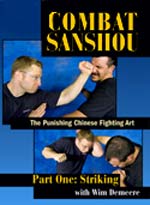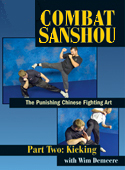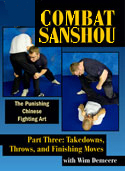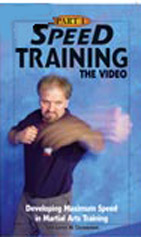|
In This Hub:
Adrenal Decay Alpha Behavior Angles Bullies Distance (range) Effective Movement Failure To Perform Fear Five Stages of Violent Crime Grappling High Risk Behavior Krav Maga MA/SD/DT Training Mental Preparation Mushy Movement Power Generation Provoking An Attack Pyramid Personal Safety Receiving Force Self-Defense SD Training Shadow Dancing Shortcuts & Cheats Stance Survival Mindset Technique Unintended Consequences Unnecessary Movement Western Ethics and SD LEO-Military Hub Knife Fighting Hub Legal Hub Martial Arts Hub Psychological Survival Hub Rape Hub Robbery Hub Self-Defense Hub Street Fighting Hub NNSD Home Page
Marc MacYoung? |
on the size or strength of your opponent. If those are problems, then something is wrong with the system, your application -- or, more likely, both. Fortunately, with a little bit of skull sweat and practice you can fix both of those problems. MM On this page: When a student reports that a technique didn't work, there is nothing that will send us howling up the wall faster than hearing an instructor respond "Well you did it wrong." And we don't care if it is a martial arts instructor, a self defense teacher or a defensive tactics instructor, We've heard them all say it. Our attitude is simple: Failure to perform is most often a failure of the system and/or the instruction -- not the student. Our reasoning for this attitude is simple. It can be summed up in one, very damning question: Why weren't the elements -- that would make that move effective -- ingrained in the student? We're not talking knowing techniques. Nor are we even talking about performing a technique. And we are most definitely NOT talking about doing a move "right(1)" What we are talking about is far, far more fundamental. What we are talking about are the underlying principles and components that make techniques work. Not only work, but work effectively. These elements are akin to the engine of a car. They must be present in order for it to run. Without these elements, all you have is a shell of a technique. What we are asking is: Why were the factors of body movement, range, stance and structure -- elements critical in order for ANY move to work -- not ingrained into the student before he/she attempted to execute the technique under stress? To fully understand what we are talking about here, we must ask you to flip your thinking 180 degrees. That is to say to look at technique from the other side. Most people involved in training believe: The technique is what gets the job done. This is false. One of the the most important things students -- AND teachers --must realize about a technique is that it is only a means to manifest physics. It is not the physics themselves. The technique is NOT what gets the job done, manifesting the physics is what makes the technique work. Let's restate that for clarity: Just doing the technique is not going to "Git -R- done." (2) Within the technique is the potential to generate certain forces. But in order to do so, certain criteria must be met. If you don't meet these criteria the technique is going to fall apart and you will fail to reach your goal. This is not a matter of doing the move "right." It is more a matter of making sure that what you need to generate power is there. In essence what we are asking you to do is to look at techniques in a new light. So instead of looking at it as a whole (and expecting it to just work), looking at the components that make it work. This is akin to the differences in how a driver looks at a car and how a mechanic looks at a car. A driver jumps into a car and expects it to go. Whereas a mechanic looks at a car from the perspective of smaller systems that work together. If any of those component systems aren't working, the car doesn't run. You have to become a mechanic of your defensive systems. There is more to being effective than just doing a technique. There are components that must be present for the technique to work. It doesn't matter if you know the technique; without these elements, all a technique is is waving your arms. Realize that we have just spoken heresy. In fact, we've just contradicted how most martial arts, defensive tactics and self-defense is taught. They teach the technique and expect it to do the job. We don't. And because we don't there's a pretty harsh charge against many instructors. What we are asking these instructors is akin to asking,"Why weren't there any bullets in the gun before you sent your students out into a firefight?" Or, a more civilian version, "Why was there no gas in the car before you sent your students out on the road?" In short, we are asking why were these critical components -- that make the whole thing work -- NOT ingrained skillsets on the part of the student? That means that the student should be able to do them out of unconscious habit. We want to know: If the student remembered to do the technique, why couldn't he/she remember these components? Components that would have made it work. Often when we ask these questions we are met with responses that start, "Well in a crisis, adrenalin..." Okay, we'll be the first to admit that things tend to go pear-shaped in a crisis and under adrenalin. But we'll also qualify it with: Especially if skills are required that you don't have or don't normally use. That puts it right back into the instructors lap. There will be decay of existing skills, motor-nerve coordination and perceptual changes in a crisis. That's a given. But there has to be skills there in the first place in order for them to decay. If there aren't, then you aren't talking decay, you're talking about totally falling apart. With this in mind, let us ask you a question: Ever had to rush someone to the hospital? Especially your child? Did you suddenly forget how to drive because you were in a crisis and adrenalized? Or, did you drive like a bat out of hell? It should be obvious that while you didn't drive as well as you would normally, the fundamental knowledge, skillsets and habits of driving didn't suddenly evaporate. In fact, despite the crisis you were able to drive the car at pretty high speeds. You could do so because you drive everyday and those skills are ingrained. Here's our point, even under crisis ingrained habits and skillsets don't abandon you. However, if these elements are not ingrained, the technique will fall apart. And that is what happens to most people. It isn't that crisis and adrenalin "destroy" their techniques, their techniques weren't effective in the first place. Crisis just revealed the flaws. The power doesn't come from the technique. Power comes from the principles and physics that a technique manifests. The consistent creation and application of those physics in your movement is what we mean when we say the skillsets you must master and ingrain. These are the elements that technique is based on. That's the difference between flailing and delivering power. In fact, you can think of the technique as "driving" and these elements the equivalent of the basic driving skillsets of steering, accelerating and braking. Without these three skillsets, you aren't going to be driving the technique, you're going to crash. Which is usually what happens when a technique fails to perform as advertised. How successful are you going to be driving to the hospital if your brakes fail? How successful are you going to be in a defensive situation if you hit someone and your arm acts more like a giant spring instead of a club? In essence our big question isn't why did the student fail to achieve these critical standards? No, in fact, our question is more along the lines of why didn't the student even know these standards were important -- much less critical? Could it have been an over-reliance on the technique to do the job instead of focusing on the elements necessary to get the job done? These elements not being present in a system, or ingrained during instruction, indicate a failure to perform. But not on the student's part, but rather on the part of the system's curriculum, the instruction or both. Primary
& secondary questions In our book with Tristan Sutrisno Becoming a Complete Martial Artist: Error Detection for Self-Defense and Martial Arts we discuss the difference between primary and secondary questions when considering why a move "failed." The primary question is not "What did I do wrong" but rather "What is wrong with the move I just did?" The differences is the emphasis of the question. "What did I do wrong" is on you. The emphasis of the question "What is wrong with the move I just did" is on the move itself. Before you blame yourself, check to see that the move itself isn't critically flawed....or, even more common, only has a specialized application. One that is inappropriate for what you wanted it to do. Many "limited use" moves are promoted as all-encompassing, multi-use, "works in all kinds of situations" techniques. That sounds good in the dojo, but will have you spitting teeth if you try to use them at the wrong time. Many of the "errors" that have crept into the martial arts, self-defense and defensive tactics training will start revealing themselves when you start considering both primary and secondary questions. In how we use the word, "errors" refers to lost components and/or change of emphasis more than it does than a malicious or stupid mistake. It is not our intent to point fingers and blame. In fact, "errors" mean the small variances the begin to creep in when the fundamental has been lost sight of. These variances cause the move to slowly drift away from meeting the standards of the fundamental -- such as "the purpose of a block is not to get hit." If that move doesn't regularly meet that standard, there is something wrong with it, not you. So before you blame yourself, or accept blame for failure to perform, first look at the move itself and see if what you were taught works. Return to top of page Basics and fundamentals:
What's the difference? While this may not seem like much of a difference, the distinction is important. The difference between the two is best explained in the following manner. A basic is where you start when teaching a system. A fundamental is what makes that system work. You use basics to teach, you use fundamentals to do. If a basic is the front door to a system, a fundamental is the foundation. A fundamental is a foundation that not only supports, but guides the framework (and application) of a system. It is what the system is built on. We will be the first to say a basic may be a component part of a fundamental. But the fundamental is why it is there. Usually when it comes to failure to perform, it isn't the basics that are missing, but rather the fundamentals. What is important to realize is that basics must work within the context of the fundamental. If you ever lose sight of your fundamentals, then your basics will also reflect this loss. Without a "performance standard" rooted in fundamentals, tiny "errors" will begin to creep in. In time you will have basics that largely consist of composite errors. No one thing is wrong, but many small things are. When that happens the basics will lose their meaning and usefulness. Without the fundamentals, the basics will no longer work. It is not any one -- easily identified --major error that rob the "basics" of their effectiveness. It is the compounding of many small "errors" Little "tweaks" that creep in over time that are, at first, not held up to the standards of the fundamental to be corrected. Later, after they are accepted as "right," these tweaks are explained away with fantasy interpretation(3). Sad to say however, you won't discover that what you know doesn't work until you are in the middle of an attack. Return to top of page Lost components The problem is that the loss of these "standards" is
often not immediately obvious. If a move is blatantly in error, then it will be
immediately apparent. For example someone who doesn't understand range can --
and often will -- throw a punch from so far back that it doesn't have a chance
to land. But what if the "error" is a matter of inches? A move can be executed
"perfectly" except for the fact that your elbow is three inches too far over.
Those three inches will have dramatic impact on your maneuver's
For example, take the generic hard style martial arts "high block" It is not uncommon to see this block performed both "too high" and "too far out." While some kata purists will insist that it should executed so your first knuckle rests on your hairline/forehead. Others will equally insist that it needs to stop some inches above the top of your head and out from your body. From a "kata" standpoint, there is no way to "prove" who is right. In either case, "that's how it is done at that school" However, from a fighting or blocking fundamental standpoint, neither are effective. They just don't meet the standards of what it takes to keep from getting hit. Coming straight up to your hair line is not going to give you either the time or distance to effectively deflect an incoming punch. This is not an issue of style or traditional martial art form, it is physics, plain and simple. This move doesn't stop his momentum (you don't "catch his punch"), it deflects it. As such, the factors of time and distance come into play. Any blow heavier than a fast "probing" jab will need more time and distance to be effectively deflected away from you. Whether his punch blows through your "block" and hits you square in the face or you deflect it somewhat upwards into your forehead, you're still going to get hit. Conversely "too high and too far out" is a bad combo because you have "chased the punch." Although it is instinctive to try to get danger as far away from us as possible, by trying to push it as far away from us as possible, we leave ourselves extremely exposed. There is no way that you can get your hand back down in time to prevent his second (low line) punch from landing. In short, blocking high up and way out leaves your body horribly exposed to the next attack. I have created another time and distance issue, one that I cannot get back in time in order to defend myself from his next attack. Furthermore, this "block" is specialized against only one, very specific, type of attack. It not only doesn't work against other attacks, but it is of questionable effectiveness against even an "overhand" blow. If you are even slightly out of place, or it is a very heavy strike, the structure of your arm will collapse when struck. The purpose of a block is "not to get hit." By simply standing in front of the mirror and practicing these different blocks you will see the "errors" I am talking about. Don't "look at the block," instead "look at your body "through the block." See if your block "covers" your body. By doing it this way you will see where you are exposing yourself with how you are doing the move. If your block doesn't "sweep" over your body, that is where you will get hit. And as my co-author Tristan Sutrisno often warns, "If you can see the openings, so can your opponent" Those openings are where you will get hit through. Which makes it a failure to perform, not on your part, but the block itself. We've already stated "the purpose of a block is not to get hit" We have also shown why those two "traditional" high blocks will fail you in an altercation because neither meet the standards you need in order not to get hit. But, what if you create a "hybrid?" Actually a hybrid is the wrong term, instead let's say: What if you create a source move? By this we mean a move that contains both elements that either "extreme" has isolated and overemphasized. This is to either way of doing a high block is taking a particular aspect and over emphasizing it while excluding the other. By putting these two emphasis's and putting them back together you will get a working solution that contains elements of both.
Notice the difference between this position and either so-callled 'traditional kata' positions. To start with your hand is far enough out to give you the time and distance to deflect an incoming straight punch. Second, it is far enough out to interfere with the "hub" of any downward strike and lessen its force. Third, because your hand is in front of you, you are in position to cover either high line or low line against his next strike. Neither of the two previous poses would allow you to do all three. By positioning your arm in this manner, instead of either of the more "traditional martial arts" manner, you will find that this becomes a very effective block. And it doesn't matter where you meet the blow or what "type" of blow it is this (which is to say it doesn't matter if it is a straight punch to your face, an overhead blow or even a left hook). You meet the goal of blocking "Don't get hit." This is a process we call "error detection." It is the topic of the book Becoming a Complete Martial Artist: Error Detection for Self-Defense and Martial Arts by Tristan Sutrisno and myself (Lyons Press). This high block is just one of countless "errors" that have crept into training that rob you of your effectiveness. These errors are more often the true source of martial arts and/or defensive tactics training failing during application than "the student did it wrong." Because even with someone who has "top form" can only make these kind of moves work about 75% of the time...and that the best you can expect after years and years of practice. If on the other hand, you have done error detection on
your systems so that your moves meet the fundamental standards, with practice
you can easily up your level of success to about 95%
Self-fulfilling prophecy The problem is most people do not have faith in their flawed training. As well they shouldn't. The problem with that is that such doubt tend to lead to "hedging one's bets." Because they don't expect it to work, they try to position themselves where they can retreat when it doesn't work. This means that to add to the existing problems, individuals hesitate and fail to commit. Now you have a half-baked technique being done half-heartedly. This is the recipe for disaster. General George S Patton once said: A good plan violently executed now is better than a perfect plan executed next week. This simple statement explains a great many things. First off it explains why 90% of all Saturday night punch outs in bars are won by the person who is not only the aggressor, but the one who attacks with more commitment. The truth is most punch outs are not sophisticated displays of fighting prowess. In fact, most of the time the person just repeatedly does the same thing until his victim falls down. That is to say, Grab, punch, repeat as necessary is the sum of their fighting strategy and technique (Although, get grabbed by the guy trying to keep from getting punched, falling over and rolling around is also a popular theme). The reason this strategy works is it overwhelms an untrained opponent...and it's really good at doing it. Furthermore, people who use it have had good success with it. In other words, they have faith that it will work. So when they do it, they will be committed. What their techniques lack in perfection is more than made up for by their gusto. Second, it also explains why flawed techniques fail when your opponent is committed and you aren't -- because you don't trust your technique. He's coming in hard and fast because he has faith in what he knows. You're not because you don't. You won't be defeated by perfection, you'll be defeated by someone's faith in "violently executing good enough." Third, although it doesn't address it directly, we can take from this statement the understanding that "Tomorrow never comes," much less next week. Quite often in seeking the perfect plan, we never reach it -- especially if someone is busy trying to play show-and-tell with our vital organs. In a physical confrontation you need to focus on immediately removing your opponent's ability to attack you. Because if he still can attack, then there is a good chance you will never get to the point where your super-duper offense even gets off the ground, much less ends the encounter. While this issue of faith, how to create power and how to make every move you do an attack are explored in more depth in Secrets of Effective Offense, what we would like to do here is to give you an important paradigm shift that will help you develop faith -- and by extension add power and effectiveness -- in your moves. And that is to redefine your goals. A few years ago, we had the misfortune to know a young man who discovered the hard way that his strip-mall black belt did not prepare him to handle a knife wielding, mentally ill attacker. His downward block was right into the knife slash. Two years later, the young man is finally recovered near full feeling and mobility in his arm/hand. He survived, not by trying to stand there and fight, but by turning and running. His attacker (who was later committed to the psych ward) chased him for a bit before, giving up the chase and fleeing back into his apartment. The thing is that young man, went into the situation with the wrong tools and the wrong goals. What is important to realize that his actions were consistent with those goals. When he saw the attack coming his only thought was to block it. That is exactly what he did .. and he got slashed for his trouble. The fact is that his plan stopped at blocking the attack. And that is the wrong goal. What was his next move? What was his bigger goal? His goal -- since he wasn't backpeddling -- should have been to stop his attacker. Had that been the case, the block would have only been a smaller step in a larger strategy. Furthermore, instead of just standing there trying to block, had he either retreated or advanced he would have changed range. Backing away, he's out of the knife's range, moving in would have turned the block into a deflection and it would have worked. By having the goal of stopping his attacker he then would have started in on removing his attacker's ability to do so. The young man was also belted in judo. And nothing stops a knife attack like picking your attacker up and tossing him on his head onto the concrete. All in all though, the young man didn't have either the faith in his skills or the goal to "end it." While both would have been preferable, their lack left him a sitting duck in knife range. Without these greater goals, the technique he used failed him. The moral of this story is this, don't expect your training to protect you. Your best 'protection' is to end the situation as quickly as possible. As such, if you try to hang back so you will be safe, you greatly increase your chances of getting hurt. This is what happens if you try to wait for a perfect plan to develop. If you go in with the intention of putting him down, you will have far more power and be more effective than if you try to hang back and let the technique put him down. This is why, in NNSD one of our training paradigms is "Git-R-done." You'll get better results from a flawed technique -- that you violently execute on your way to a bigger goal -- than you will trying to find the perfect technique that will protect you. Now if, on the other hand, you have applied error detection to your training and developed effective offense, it's really going to work great. Because while a good plan is good enough, a perfect plan violently executed now is even better -- especially if you have the powerto back it up. In closing Putting it bluntly, we're not big fans of either camp. There is a lot of misconduct in the business/culture of commercialized martial arts. Arts that are being taught under the banner of "Traditional martial arts" And sad to say there is a lot of bad information and flawed techniques being passed on, primarily arising from sport based systems being sold as self-defense. This group often insists that the techniques -- if not the style -- will do the job On the other hand, many Reality Based Self Defense organizations are dangerously deluded about the complexities of violence. There are many powerful and dysfunctional behavioral patterns going on underneath the surface of these groups, including simplistic and violent fantasies, cult-like activities, an obsession with streetfighting and/or knife fighting and a total disregard for the legal complications of violence. This group distains the idea of technique and instead relies on physical conditioning and ferocity to get the job done. In short, neither group is without stain and both are raking in money from their followers by claiming that they have the answer. Unfortunately, both also share the critical flaw of moves that don't have what it takes to be effective. One of the bigger condemnations that the RBSD crowd has against TMA is their over-reliance on technique. Which in light in of the information we have covered on this page, has validity. A technique that lacks the elements that we have discussed here will fail. It doesn't matter if you have practiced it a thousand times in the dojo, it's a car that is lacking an engine. On the other hand, bad attitude and physical conditioning does not good physics make. While these elements do indeed carry the day in many barroom brawls and scuffles in the locker rooms, they will not help you against either a skilled or bigger and nastier opponent. In these cases, your moves have to deliver power. Which translates into doing the technique in an effective manner. If your moves are not effective for power delivery, such a person is going to throw you a beating. So in a real sense, many RBSD and combative instructors are throwing the baby out with the bathwater in their dismissal of proper technique. In emphasizing quantity over quality (throwing a whole lot of whatever move as hard and fast as the student can) they are not only ingraining bad habits (poor structure/bodymovement and no understanding of range), but they are setting their students up for failure when they face anyone tougher than a drunk in a yuppie bar. The bottomline is you can hide a lack of effective physics behind all kinds of talk about warrior traditions, ancient martial systems and lineage. You can disguise this lack just as well behind the dust of fighting attitude, clap trap about "scientific" fighting systems, physical fitness, military combatives and ultimate streetfighting systems. But no matter how you try to cover this lack, talk doesn't create effective movement, generate or deliver power. Nor does it ingrain effective movement in the students so they can use them in a crisis. While we're at it neither the technique, nor the system provides the necessary physics either. And to really rain on the parade, training hard in a system that doesn't have these elements doesn't do it either. The only thing that provides proper physics is effective movement. And the only way a student will be able to do them is if necessary actions/elements are ingrained in the student by the instructor. If this is lacking, it doesn't matter if it is a traditional martial art, a reality based fighting system or a defensive tactics system...the chances of failure are high.
1) What we will be discussing on this page also includes
the topic on how a doing a move exactly like you were
taught can still fail to meet the physics required to make
the move work. Unfortunately in many so-called "traditional"
schools, flawed interpretations and ineffective movement is
being taught as the "right" way to do the move. Often both
instructors and students believe they are doing the move in
the traditional way without realizing that elements have
been dropped and lost.
Return to Text
2)
When you stop to think about this, you realize exactly how
endemic this kind of thinking is. We are constantly barraged
with queries as to what is "the best martial art for
self-defense?", "what do we think of this or that system?"
and "is this style better than that one?" There is a belief
that it is
the system that counts rather than the individual
being effective. The system doesn't matter at all, it's what
you can do. The only thing about the system that matters is
how decayed or how intact what is being taught is.
Return to Text
3) I lie to you not.
I once heard a 'stripmall
dojo' instructor explain to his students that "the
reason "ninja" swords were straight is because the "samurai"
swords were curved is "they were mortal enemies..." I don't
know the rest because I had to leave before I laughed out
loud. Although I do pity his students and the quality of
training they are getting. To start off, there are no such
things as "ninja swords" Straight blades were called mu-zori
(no curve) and were more common to tantos than katanas.
Return to text
|

<
|
||||||
|
||||||||

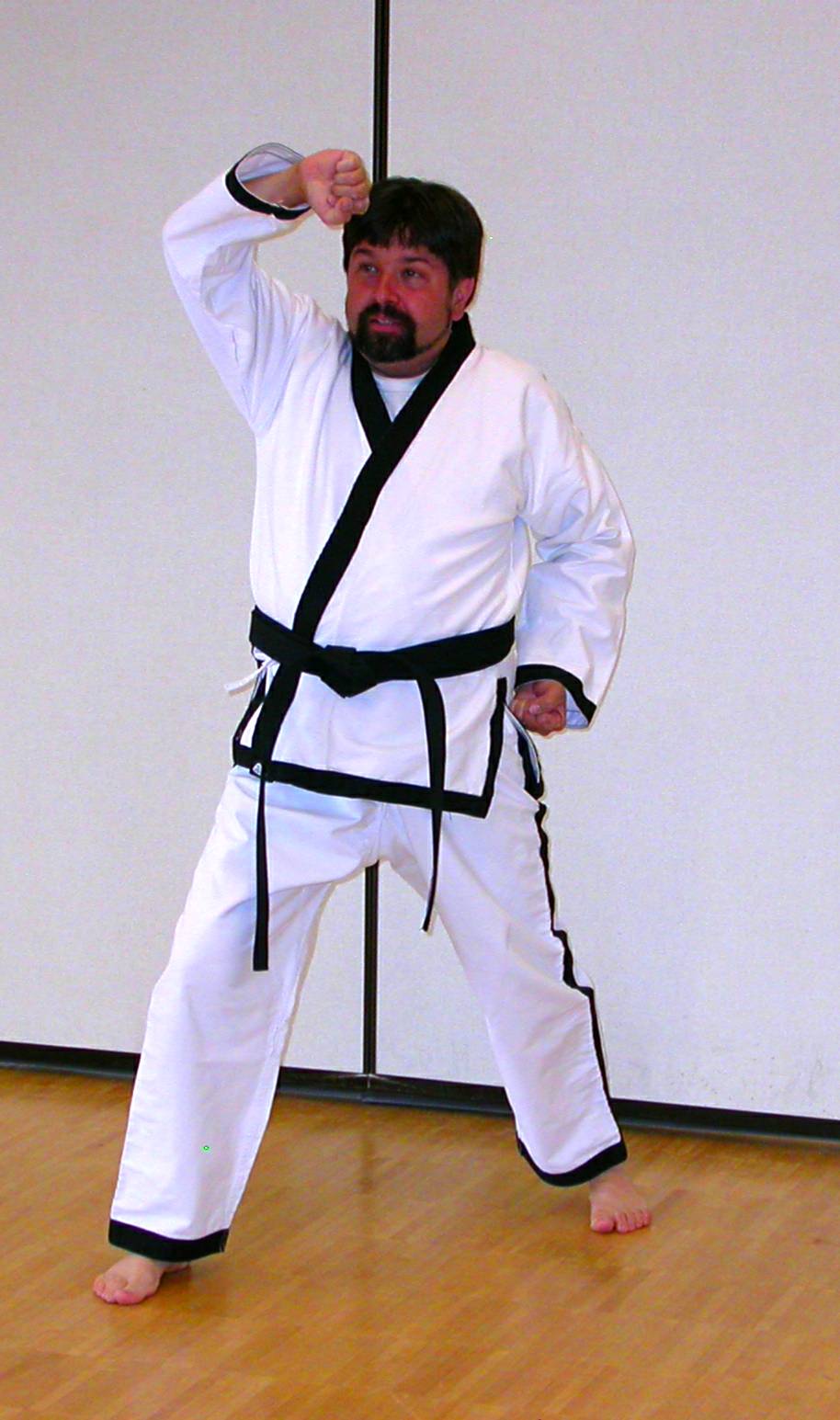 effectiveness.
But you will not recognize this error in either kata or a flow drill.
effectiveness.
But you will not recognize this error in either kata or a flow drill.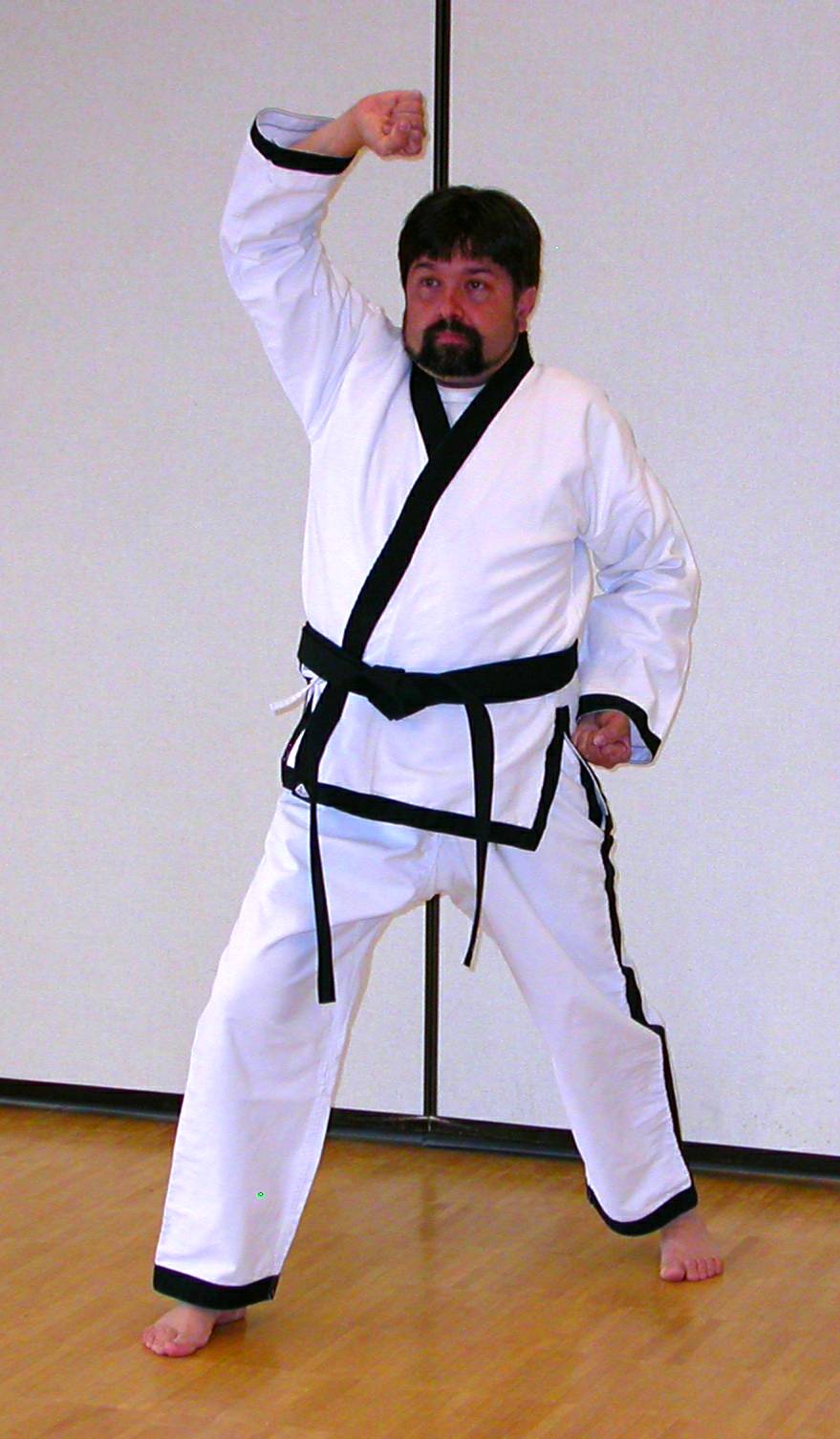
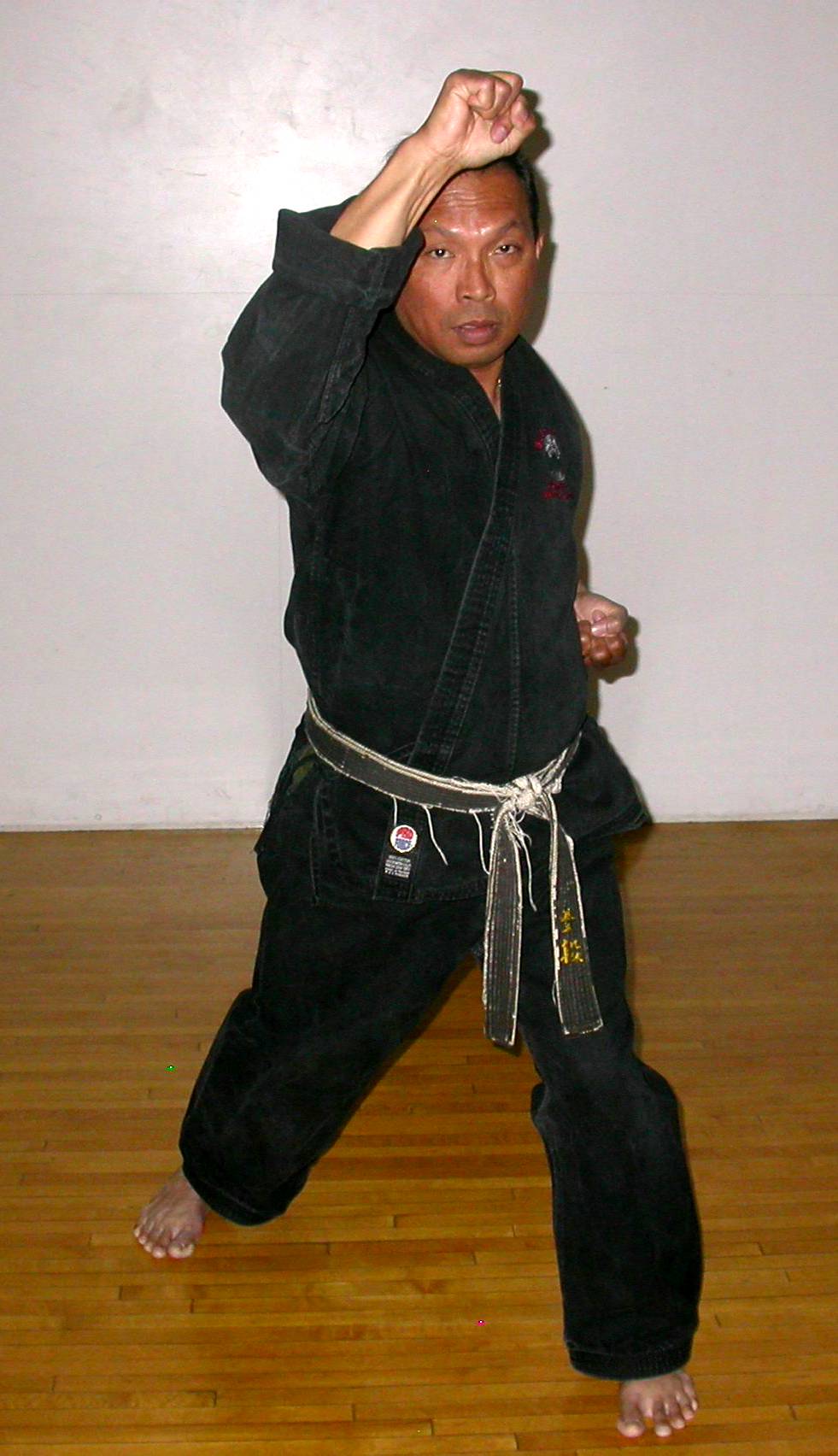 Try
this in front of a mirror. Raise your thumb to your hairline (or to the top of
your left ear),
Try
this in front of a mirror. Raise your thumb to your hairline (or to the top of
your left ear),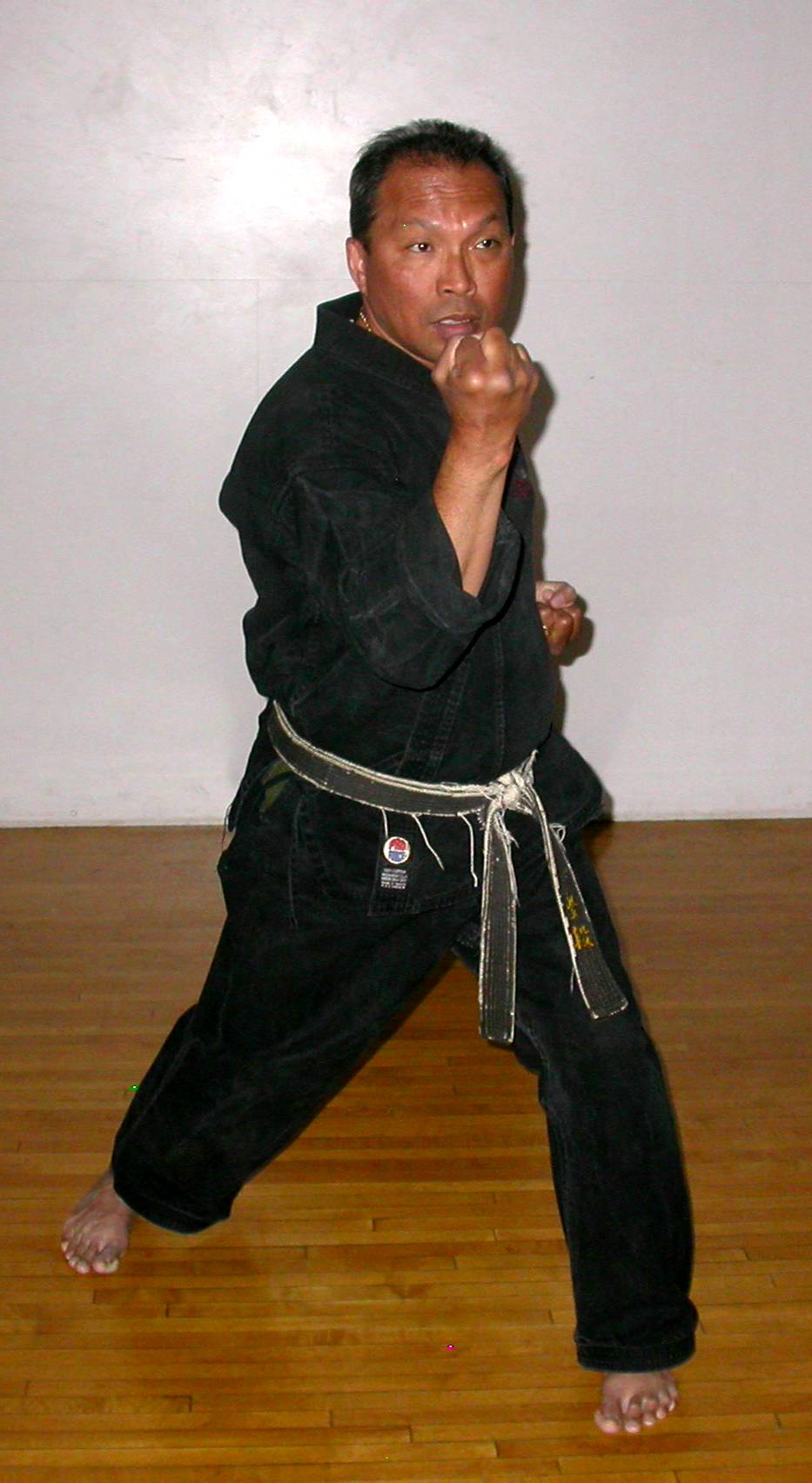 but do it so your arm is about a foot straight out from your forehead (towards
the mirror). Now drop your elbow. When you finish, your position should look
like you are trying to shield your eye from a distant bright light that is in
front of you, but slightly to your left. (One that you want to block out so you
can see a distance in front of you.) Once you have that position fixed in your
mind, drop your elbow in front of your sternum is/was and twist your body
slightly. Your chest should be hidden behind your block. And then raise it again
to that position. In both cases, watch your body through your motion. Your body
should be covered both dropping from and rising to that position.
but do it so your arm is about a foot straight out from your forehead (towards
the mirror). Now drop your elbow. When you finish, your position should look
like you are trying to shield your eye from a distant bright light that is in
front of you, but slightly to your left. (One that you want to block out so you
can see a distance in front of you.) Once you have that position fixed in your
mind, drop your elbow in front of your sternum is/was and twist your body
slightly. Your chest should be hidden behind your block. And then raise it again
to that position. In both cases, watch your body through your motion. Your body
should be covered both dropping from and rising to that position. 




